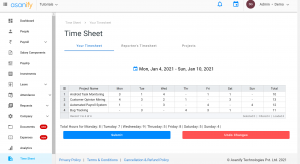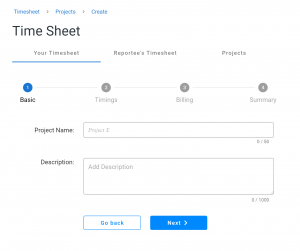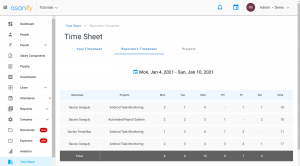Tracking time with a timesheet isn’t merely a way to pay teams and contractors. As project-based work becomes more common, Timesheets have also become valuable for businesses to monitor their time and keep projects on track. In this blog, I will be talking about the following:
- What is timesheet management?
- What is an employee timesheet management system?
- Which are the elements of a project timesheet?
- What is the use of a timesheet?
- What is effective timesheet management?
- How to overcome resistance to using timesheet?
- How to get employees to fill in timesheet?
- What is the difference between manual timesheet and an online timesheet software?
- What should you look for in an online timesheet management system?
- How to create a timesheet in Asanify?
- Are timesheets good or bad?
- What are some of the best timesheet software?
- How often should you fill out a weekly timesheet?
- How To Manage Absences and Vacations on Timesheet?
- FAQ
What is timesheet management?
Timesheet management is a practice of monitoring and analyzing timesheets (recorded work hours). It can also involve taking different actions (e.g. calculating employee payroll or invoicing the client based on these timesheets).
The working time used to be summarized on a sheet of paper, hence the name is timesheet. Nowadays, online timesheets are much more popular, although there are several options here as well; from simple spreadsheets to AI-powered software tools.
What is an employee timesheet management system?
An employee timesheet system is an automated timesheet tracker that sends the timesheet requests to managers as soon as an employee submits the employee timesheet form for approval. An employee timesheet system keeps tracks of the number of hours worked, additional overtime and funnel timesheet requests to managers, HR, and payroll.
Which are the Elements of a Project Timesheet?
The timesheet systems generally include the following data:
Name of the user
This is the person who is completing the timesheet. Managers may have access to complete timesheets on behalf of other people in the team.
Date
Timesheets typically show a week to view. The date field lets you navigate through the calendar and enter your working time for a particular week.
Project
Timesheets can group tasks by project to make it easier for the user to see what they are recording at a glance.
Task
The list of tasks that the user has been allocated to work on that are not yet marked as complete.
Copy Last Week
If you’re working on similar or the same tasks each week, you can auto-populate the timesheet with last week’s tasks rather than have to input them again.
Days of the Week
The rest of the timesheet columns display the days of the week. Mark the hours worked on each task against the correct days.
Percentage Complete
See what percentage of your tasks are done.
Auto-totals
Columns and rows will automatically total so that you can see at a glance how many hours you have worked in a day or on a particular task.
Submit the timesheet
If an approver has been assigned, the timesheet when ready can be sent to that person to review.
Add Notes to the timesheet
Add comments and upload files to timesheet entries to remind yourself of what the task was about or to note why it took longer (or less time) than expected.
Additional Elements of the timesheet
You’ll also see lines on the timesheet that do not directly tie back to tasks on the project schedule. These lines could represent things like sickness, vacation time, team meetings, training and so on. These tasks take up time during the working week, but don’t necessarily contribute directly to a project.
What is the use of a timesheet?
There are various uses of timesheets other than just tracking time and paying employees. Let’s have a look at some of the uses beyond time tracking:
To build a database of historical information.
The data output from time tracking comes in the form of timesheets that show how long an individual spent doing a particular task. This is valuable data, because many of those tasks will happen again in the future. Your time tracking data repository will let you estimate better in the future because you can draw from real-life data.
For billing clients
If your commercial model relies on charging clients for your time, then you need to know how much time to charge them for. Timesheets also give you the detail so you can spell out exactly what you did on a project.
This is helpful if ever your invoices are queried, and especially when work takes longer than planned because of changes the client requested.
To manage your workload
People are often surprised when they start to track their time. They can see exactly where they are spending the most effort. And it isn’t always where it should be.
Timesheets can be really helpful in pointing out why you aren’t as efficient as you think you should be. They flag up where your time is going. This helps you manage your workload more efficiently. Both during a day and also over a longer period of time, for example, a week.
What is Effective timesheet management?
Calculate the cost of your projects
A must-have for companies who operate on time & materials contracts. Since you’re billing your clients for the work your team puts into the project, you might simply use their timesheets as the base for your invoice. Many resource management tools allow you to export the timesheet data or share it externally.
Find room for improvements and savings
Analyzing your team’s timesheets is a great opportunity to dive deeper into the data and identify improvement opportunities. Many time tracking tools offer an option to tag recorded time entries with predefined categories or add comments to them. This way you can analyze how much time of your team goes into non-billable activities.
Forecast resources
Previous data, such as timesheets, can be also used to forecast recruitment needs. Looking at the numbers from previous years or months, companies are able to spot trends that are likely to happen again.
Identify problems before they escalate
Sometimes project difficulties are fairly simple to notice just by looking at the recorded timesheets. For example, people may start logging a lot of overtime in order to deliver the next milestones.
It’s a good practice, however, to regularly compare your team’s recorded time entries with the estimated schedule. This will allow you to spot any inconsistencies before they result in missed deadlines.
How to Overcome Resistance to Using Timesheets?
One of the concerns that you might hear from managers is that the team will not like using timesheets. Because of this seemingly common sentiment, it can be daunting to move to time recording when you haven’t previously worked like that. Introducing time tracking where it isn’t already in practice is a huge change for many companies.
If there is resistance in your organization, take a step back and ask why there is that level of opposition. It could be because:
- The employees feel timesheets are a lot of work.
- They feel micromanaged.
- They feel that timesheets could be used to penalize staff who don’t log enough hours.
The best way to deal with these concerns is to sit with the team and explain what you are doing to address them. For example, if they are worried that completing their timesheets will be a hassle, show them how easy it is to click and submit using online time tracking software.
When you know why team members are resistant to tracking their time you can manage their concerns individually.
How to get employees to fill in timesheet?
It comes as no surprise to anyone in the business world that there is one cardinal rule when it comes to employee time tracking: employees don’t like to fill out timesheets.
It’s this fact that makes supervisors and managers constantly struggle to collect everyone’s completed and accurate timesheets. Here are a few tips that will help get employees to fill in their timesheets on time:
1. Keep It Simple
Timesheets should not take more than 5-10 minutes to complete each day. When an employee is using a system that takes 30 minutes or more just to track their hours, the employee gets frustrated and the company loses considerable time that would be better spent on other activities.
2. Make Submissions Easy
Many companies employ complicated or tedious time tracking processes. Simplify or automate part of the process with Asanify and your employees will submit their timesheets without delay or complaint. Get started for free!
3. Explain the benefits of a timesheet
Communicate how the timesheet data is going to be used. Explain the value of time entry to all staff members. If the data helps to reduce the amount of multi-tasking, communicate that. By clarifying the process and explaining how timesheets help speed up the billing cycle and increase cash flow – thus gaining the ability to take on more projects, you make them understand and want to help.
4. Be Flexible about How the Time is Tracked
If you don’t want employees watching the clock and getting creative with 15 minute excuses, don’t demand timesheets that are precise to the minute.
5. Limit the Number of Time Tracking Items
If you do not want your reports to become nightmares, limit the number of tabs you’re tracking. Group items such as internal meetings, product training and conference calls into a single category. It will simplify your reports and make it easier for employees to log their time.
6. Automate Time Tracking
Eliminate as many manual processes as possible. It will save countless hours of timesheet-related administrative work for the employee, and will help reduce the potential for human error in each submission , hence, saving the approver’s time, as well. Automating the process also makes the timesheet more accessible to employees, no matter where they are located.
7. Use Automated Reminders
A system that automatically reminds the employee when the timesheet is due will help you collect those timesheets on time, and reduce the number of tardy submissions.
8. Don’t Penalize People for Being Honest
It is relatively easy to get staff to report on project time, but quite difficult to get staff to report (consistently and without fear) on non-project time. Rather than penalizing employees for spending time on other things, use the information as an opportunity. Identify the source of the issue and fix it. You may discover a legitimate internal issue that requires tracking , such as morning meetings or training.
9. Pick Your projects
Some projects require extra time entered for project management. Some projects can be easily managed with results. If your team is achieving results on time and within budget, do not criticize them on timesheets.
10. Avoid the Reward / Penalty System
While penalties may solve the problem in the short term, it is not good for the long term. Using a penalty/reward system can undermine team unity, and create an atmosphere of distrust between employers and employees , things you want to avoid if you’re creating a long lasting company and looking to boost employer reputation.
What is the difference between Manual Timesheets and Online Timesheet Software?
Timesheets keep track of team hours, but is it worth investing in an online timesheet software. Certainly, small businesses that don’t have to keep track of a lot of employees might get by without. But once an organization scales up, so does the complexities of ensuring proper payment to their employees.
Customizable
One advantage of an online timesheet compared to the old-fashioned way of logging hours is that you can customize them to fit the structure of your business. Not all companies are the same—they work in different sectors and have different needs when processing payroll. Online timesheets have the flexibility these businesses need to get their timesheets tracking more accurately.
Reporting
The problem with paper or even a digital spreadsheet is that they’re data islands. While they’re functional they don’t go beyond the basic needs of a timesheet. For example, an online spreadsheet has a central repository that can then be tapped to generate reports that give managers an insight into how their teams are working and also the information to track the time in projects.
Security
Having an online timesheet software means that it can be electronically locked, keeping anyone from changing the information held within. Once a manager approves the timesheet, they can secure it to make sure that what arrives at payroll is the same as what they saw. No one can come in and change the numbers.
Easy Access
Paper timesheets have to be physically distributed, and even digital copies must be sent electronically. However, an online timesheet software is accessible anywhere and at any time. If you’re managing remote employees who work in different locations and time zones, they can log into their timesheet when they need to update it without requiring you to send it to them.
This doesn’t even speak to having timesheets that are integrated with a larger project management software and can update automatically as teams submit their status. While not being completely dismissive of the classic timesheets, the online timesheets are what the workplace needs.
What should you look for in an online timesheet management system?
To choose a tool to automate your employee timesheet process, here are a few key pointers you must go through:
1. Don’t compromise on integration
Pick a solution that is easier to integrate with your payroll platform, employee database system, employee portal, etc.
Also, you don’t need dedicated software for the sole purpose of timesheet tracking alone. Attendance monitoring is just a subset and it relates to the broader aspects of HR. Therefore, you can choose a HR software that treats timesheet management system as part of its overall operations instead of treating it as a separate issue.
2. Aim for the cloud
Cloud-based timesheet software is integration-ready and also accessible to your users at any time and from anywhere. Accessibility on the cloud is also a great advantage if your company has employees or teams working from remote locations.
3. Be picky on the UI/UX
HR personnel are not best known for being tech-savvy, so they need software that they can use on their own without bothering the IT team. Look for software that has easy to use interface, drag and drop design, customizable features, low or no coding options, and so on.
How to create a timesheet in Asanify?
Timesheet software is a key component in tracking time spent on tasks and also projects to make sure you stay on schedule. Here are the steps on how to use timesheets on Asanify:
1. Create Your Project

Timesheets are much easier to manage when you have an idea what tasks employees will be working on ahead of time. You should begin with laying out the tasks that you’ll need to reach your final schedule.
2. Invite Your Team
Assemble your team and invite team members to the project. Choose members who have the experience and skillset to tackle all the tasks required to get the job done.
3. Add and Assign Tasks

Tasks are the building blocks of your project, and thoroughly planned out task lists direct your team throughout the entirety of the project. Therefore, practicing proper task management, with clear direction and other details, is essential.
4. Designate a Timesheet Approver
Assign someone from the team who will receive the submitted timesheets. This person will make sure that the work hours match the tasks completed.
5. Have Team Members Log Their Hours
Each team member is responsible for tracking the hours they work on a task. This information is then collected on the timesheet. Log hours on individual tasks, or log them on the timesheet.
6. Review the Timesheet

After the requisite amount of time has passed, typically:
- weekly,
- bi-weekly,
- monthly, or
- bi-monthly,
it’s time to review the timesheet before submission.
7. Submit the Timesheet
Submit the timesheet to the approver on the team who approves them is the next step of the process.
In order to ensure you submit your timesheets in a timely fashion, you can set up notifications that can be set up at a certain day/time every week.
8. Approve Timesheet

The approver will receive the timesheet and must look over the hours and tasks to make sure there are no mistakes. If there are any, then the timesheet needs to go back to the person who submitted it.
9. Make Reports
Now that the timesheet is approved, you can take your time tracking even further by using HR reports. Reporting is useful to go over all of your data and identify hindrances, overages and other disparities. They are also an essential tool for keeping stakeholders in the loop.
Are timesheets good or bad?
Managers tend to fall into two categories when it comes to time tracking:
- They either understand the value of timesheets and are huge supporters, or
- They don’t see the point and believe it undermines trust in the team.
If you fall into the second category then, this will also explain why you should be reconsidering tracking time on your projects.
You can only manage what you measure. Successful project managers know how far through their project they are at any time. This information helps them establish whether they are ahead or over budget and whether they are going to hit their upcoming deadlines.
Unless you know how long a task has taken, and can compare that to how long it was scheduled to take, then understanding the performance of your project is much harder.
What are some of the best timesheet software?
- Asanify
- Harvest
- Clockify
- T-sheet
- Toggl
- Hubstaff
- Wrike
How Often Should You Fill Out A Weekly Timesheet?
There is no hard and fast rule about this, but generally it’s better to complete them as soon as you can so you remember what you spent your time on.
If you don’t have that many tasks, it’s likely you can manage it by completing them once a week. If you have a lot of separate tasks to do in a day, then it’s better to spend a few minutes recording your time just before you log off for the day.
How To Manage Absences and Vacations on Timesheet?
Sometimes you won’t want to record time against project activity because a staff member is off sick or on annual leave.
The easiest way to manage this is to set up an ‘admin’ task called ‘Sickness’ or ‘Vacation’ and have them record their normal working hours against that instead.
When a period of downtime affects everyone, such as closing the office for a holiday, as per the company leave policy, you can change the working hours in the master calendar so that your team doesn’t have to record time on those days.
FAQ
Timesheet data shouldn’t be kept confidential because, your team should know what you are working on and vice versa. There’s nothing sensitive in the high level task name for the vast majority of project scheduling information. If it has been scheduled, your team can see the scheduled task anyhow.
A timesheet is a data table which an employer can use to track the time a particular employee has worked during a certain period. Businesses use timesheets to record time spent on tasks, projects, or clients.
A timesheet is a paper used to track the time each employee spends on a task. This traditional method is now available in through digital software. Employers use a timesheet to track hours worked, leave time, accruals and to make adjustments when processing payroll.
Each employee enters the hours they work in their timesheet, and then they submit it at the end of every timesheet period. They can enter the time next to available projects, tasks, or activities, and can record comments.
Timesheets should include the following:
1. Employee’s name.
2. Pay period.
3. Date worked.
4. Day worked.
5. Hours worked.
6. Total workweek hours.
With proper use of a timesheet, you can easily use it to see:
1. Who is working on what task.
2. Which tasks are still outstanding.
3. What tasks are going to overrun their scheduled time.
4. Who is working late and logging lots of hours.
5. Who isn’t recording many hours and may have capacity to pick up more work.
Not to be considered as tax, legal, financial or HR advice. Regulations change over time so please consult a lawyer, accountant or Labour Law expert for specific guidance.





